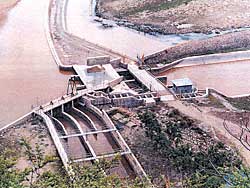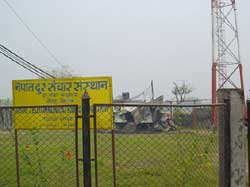 It's more than piles of dead bodies now. Ever since their latest campaign of destruction began in mid-March, Maoists have struck unguarded bridges, hydropower projects, water supply, irrigation offices, horticulture farms, forestry projects, telecommunications and government buildings. They have destroyed infrastructure that took decades to build, and it has already cost the Nepali nation tens of millions of dollars.
It's more than piles of dead bodies now. Ever since their latest campaign of destruction began in mid-March, Maoists have struck unguarded bridges, hydropower projects, water supply, irrigation offices, horticulture farms, forestry projects, telecommunications and government buildings. They have destroyed infrastructure that took decades to build, and it has already cost the Nepali nation tens of millions of dollars. It is hard to see the rationale for such wanton destruction other than an indication that the Maoists are now desperate to force the government back to the negotiation table. Or is this an attempt to bring the government down to its knees?
"Theoretically the attacks on infrastructure could be a trial-run for their final armed revolt," says Puskar Gautam, a former Maoist commander. "Or, it could be that anarchy is spreading in the ranks. Attacks on drinking water systems and small rural hydros just don't make sense to me."
The latest attacks have hit the one area where democracy had taken root and was beginning to deliver development: local self-government. Hundreds of VDC and DDC buildings have been destroyed in the past month. Not a single VDC office is intact in districts like Rukum, Rolpa, Jajarkot, Kalikot and Sallyan, says Prakash Jwala, MP from Sallyan (see: Countdown to Year Zero, below). In Dang, only two of 39 VDC offices are still there. Projects that were helping local elected officials to plan and implement decentralisation have been systematically demolished.
On 28 March, armed Maoists torched three government offices in Okhaldhunga. A few days earlier, rebels strode into Patan Bazar in Baitadi, snatched kerosene from shops and torched eight government offices looking after district irrigation, roads and soil conservation, women's welfare, agriculture development, family planning office, forestry building, the local post office.
There is so much destruction, one official in Kathmandu admits, he can't even begin to assess the damage. But he estimates that the toll on public infrastructure since November alone may have surpassed Rs 2 billion.
The most grievous damage has been to the 12 megawatt Jhimruk hydroelectric project, which was built at a cost of $ 20 million. This was a rare project by Nepali standards: it served one of the poorest regions in Nepal and was designed for rural electrification. It had its own distribution network and was selling directly to consumers in Pyuthan, Rolpa and parts of Arghakhanchi.
On 30 March a group of Maoists walked in and blew up the main control room, destroying the main switching station. Water then flooded the turbines and inundated the powerhouse. The water could not be drained because the rebels had also blown up the staircase leading to the gates.
Because it was so easy, the Maoists returned the next day looting offices and stores and carting away everything: computers, fax machines, wall clocks, curtains, sleeping bags and whatever food supplies that were left. Still, no sign of security forces. So the Maoists took their time attacking nearby government buildings, ransacking the offices of the Jhimruk Industrial Development Corporation which used to train locals in entrepreneurial skills and income generating activities.
"We have estimates but no formal assessment of damage," says Bimal Koirala, Finance Secretary. "A team will be going to Jhimruk to do a proper assessment next week." This may in fact be the first specific assessment of Maoist damage so far, and it has been necessitated because of the on-going effort to privatise Butwal Power Company which owns the project.
 The army contingent at Chernata overlooking the power plant had recently been moved elsewhere. Locally hired guards were no match for the rebels, who rounded up all 300 employees and held them hostage while they razed the power station. "We don't have a complete picture of the damages yet because we have not been able to go there," Kiran Malla, general manager of BPC told us on Wednesday.
The army contingent at Chernata overlooking the power plant had recently been moved elsewhere. Locally hired guards were no match for the rebels, who rounded up all 300 employees and held them hostage while they razed the power station. "We don't have a complete picture of the damages yet because we have not been able to go there," Kiran Malla, general manager of BPC told us on Wednesday. Earlier in the week, the Maoists blew up the Chandauta sub-station in Kapilvastu, causing damage worth Rs 5 million, and attacked another electricity station at Ataria. They have also attacked and damaged small hydros in Khandbari, Bhojpur and Okhaldhunga. The Nepal Electricity Authority had not assessed the damages in Okhaldhunga, but the loss in the two other plants was estimated at Rs 12 million. Besides NEA-owned plants, the Maoists have also destroyed numerous community-run hydro plants, which no one even seems to be counting.
So far the Maoists have attacked and damaged 37 telecommunications substations, including some major repeaters, each one of which will cost over Rs 40 million to rebuild. Phones have been dead in 12 districts
for months.
There could be some rationale to attacking highways and hydropower, but what is harder to fathom is what the rebels gain by destroying a training centre for agricultural extension in Kavre, the remote Juphal airstirp and the Dolpa'sonly lifeline, the forestry project centre in Sindhupalchok, or small hydro projects built with local initiative all over the country or the only small hydroplant in Panchthar. Or, how does it help the revolution to destroy water supply of Narayan Nagar Palika in Dailekh and Okhaldhunga's water supply?
The attacks after 20 March appear to have been part of the terror campaign in the build-up for the strike the Maoists had proposed for 2-6 April. Maoists caught trying to plant bombs in Kathmandu in the past week reportedly admitted just that.
Then there are all the other losses. The counter-insurgency operation has already cost the government Rs 1 billion since November. The crippling losses caused by the collapse of the tourism industry and manufacturing and its knock-on effect on the economy cannot even be estimated. Add to that the cost of destroyed infrastructure and it shows that the Maoists are not just fighting an insurgency,
they are systematically dismantling a nation.
By now, the rebels have dropped all pretences of trying to be populist by not attacking projects that benefited the poor. Now, anyone is fair game, and there is a frightening element of looting and plunder that accompanies the attacks.
It could be that the Maoists are responding to military pressure on their activities, and have turned to soft targets to spread maximum panic. Could it, then, be a sign of desperation? Explains Gautam: "The desperation does not explain this mindless violence. The leadership has no reason to be desperate since the leadership is safe in India and is confident the revolution is on course."


